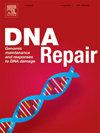DNA双链断裂修复途径对DNA交联修复的贡献
IF 2.7
3区 生物学
Q2 GENETICS & HEREDITY
引用次数: 0
摘要
DNA交联诱导药物广泛应用于实体肿瘤的临床治疗。在链间交联(ICL)修复过程中出现的双链断裂(DSBs)是治疗反应的关键决定因素,因为如果不进行修复,它们会导致细胞死亡。dsb可通过非同源末端连接(NHEJ)、θ介导末端连接(TMEJ)和同源重组(HR)修复。HR被认为是修复ICL修复过程中诱导的dsb的主要途径。在这项研究中,我们研究了NHEJ、TMEJ和HR在小鼠胚胎干细胞(mES) ICL修复中的作用。我们发现,dna - pkcs缺陷的mES细胞对交联剂丝裂霉素C (MMC)、顺铂和卡铂具有耐药性,而缺乏Rad54的mES细胞则具有更高的敏感性。此外,DNA-PKcs的缺失与HR活性的增强相关,正如MMC治疗后Rad54灶数量增加所证明的那样。与仅缺乏Rad54的细胞相比,DNA-PKcs和Rad54的联合敲除降低了对交联剂的敏感性,这表明除了HR之外还参与了另一种DSB修复途径。我们发现TMEJ缺乏可以使细胞对顺铂敏感,特别是那些缺乏NHEJ和HR修复的细胞。这表明TMEJ有助于顺铂治疗后的细胞存活。在临床环境中,在顺铂治疗的宫颈癌和头颈癌中,较高的PRKDC表达与较差的生存率相关,而升高的RAD54L和POLQ表达与较好的生存率相关。这些发现反映了在体外观察到的NHEJ与HR和TMEJ在复制相关的DSB修复中的相反作用。本文章由计算机程序翻译,如有差异,请以英文原文为准。
Contributions of DNA double strand break repair pathways to DNA crosslink repair
DNA crosslink-inducing drugs are widely used in clinical settings for treatment of solid tumors. Double strand breaks (DSBs) that arise during interstrand crosslink (ICL) repair are crucial determinants of the therapeutic response, as they lead to cell death if not repaired. DSBs can be repaired through non-homologous end joining (NHEJ), theta-mediated end joining (TMEJ), and homologous recombination (HR). HR is considered a major pathway for repairing DSBs induced during ICL repair. In this study, we examine the roles of NHEJ, TMEJ, and HR in ICL repair using mouse embryonic stem (mES) cells. We show that DNA-PKcs-deficient mES cells are resistant to the crosslinkers mitomycin C (MMC), cisplatin and carboplatin, contrasting with the increased sensitivity observed in mES cells lacking Rad54. Furthermore, the absence of DNA-PKcs correlates with enhanced HR activity, as evidenced by an increased number of Rad54 foci following MMC treatment. The combined knock-outof DNA-PKcs and Rad54 reduces sensitivity to crosslinkers compared to cells lacking only Rad54, suggesting the involvement of another DSB repair pathway besides HR. We found that TMEJ deficiency can sensitize cells to cisplatin, particularly in those lacking NHEJ and HR repair. This suggests that TMEJ contributes to cell survival following cisplatin treatment. In clinical settings, higher PRKDC expression correlates with poorer survival, while elevated RAD54L and POLQ expression correlates with better survival in cisplatin-treated cervical and head and neck cancers. These findings reflect the opposing roles of NHEJ versus HR and TMEJ in replication-associated DSB repair, as observed in vitro.
求助全文
通过发布文献求助,成功后即可免费获取论文全文。
去求助
来源期刊

DNA Repair
生物-毒理学
CiteScore
7.60
自引率
5.30%
发文量
91
审稿时长
59 days
期刊介绍:
DNA Repair provides a forum for the comprehensive coverage of DNA repair and cellular responses to DNA damage. The journal publishes original observations on genetic, cellular, biochemical, structural and molecular aspects of DNA repair, mutagenesis, cell cycle regulation, apoptosis and other biological responses in cells exposed to genomic insult, as well as their relationship to human disease.
DNA Repair publishes full-length research articles, brief reports on research, and reviews. The journal welcomes articles describing databases, methods and new technologies supporting research on DNA repair and responses to DNA damage. Letters to the Editor, hot topics and classics in DNA repair, historical reflections, book reviews and meeting reports also will be considered for publication.
 求助内容:
求助内容: 应助结果提醒方式:
应助结果提醒方式:


